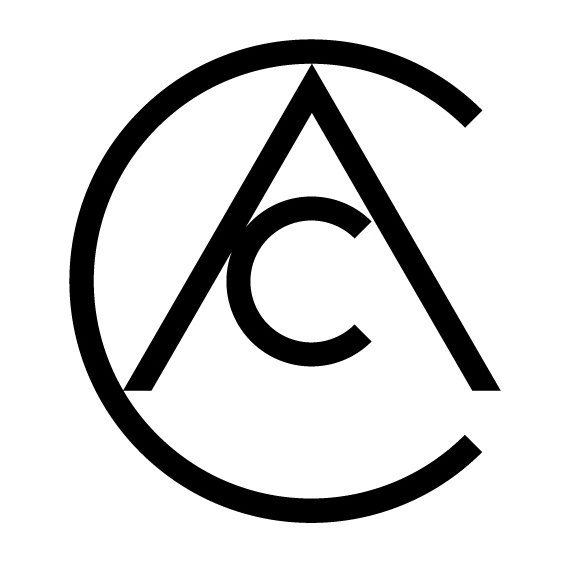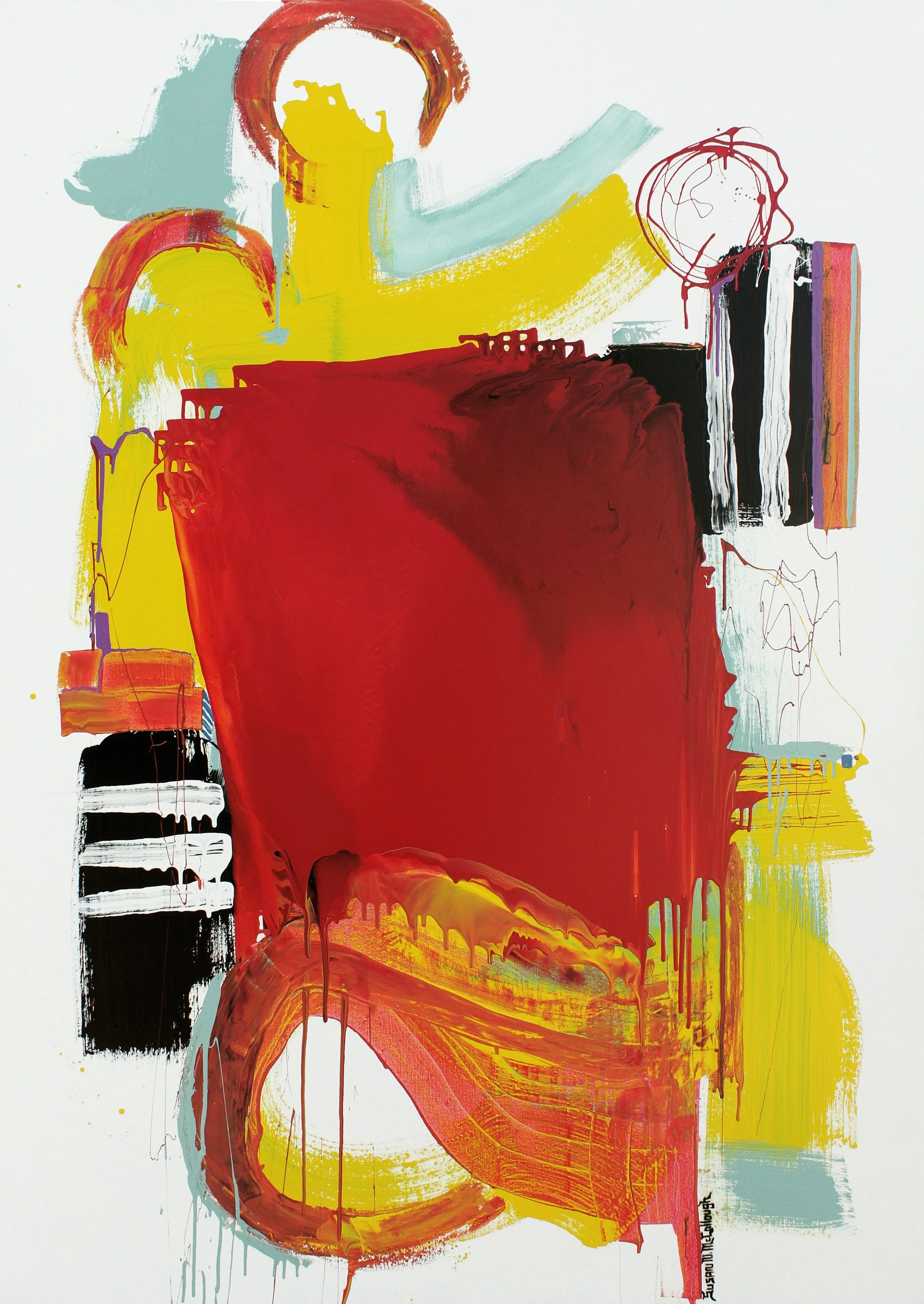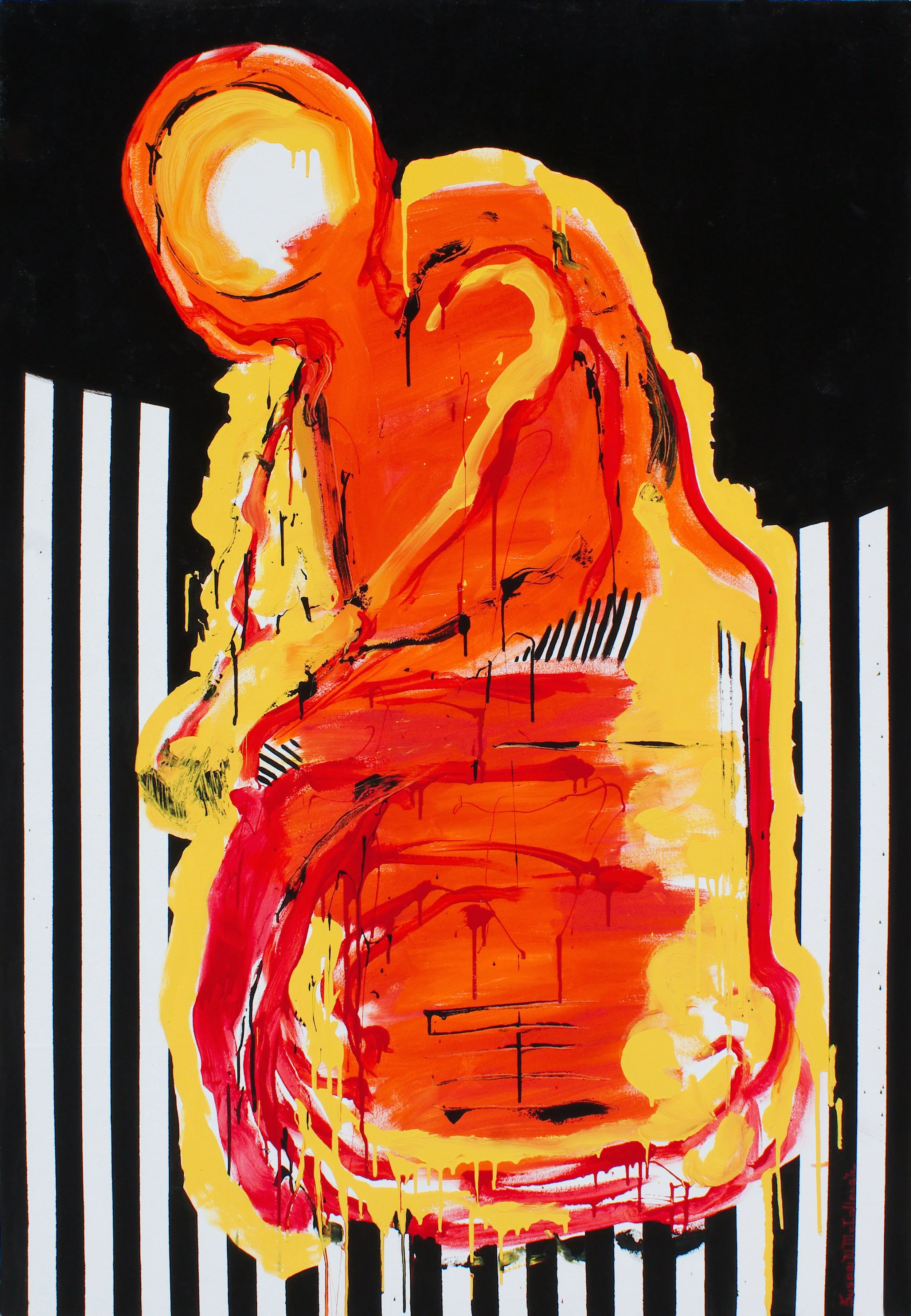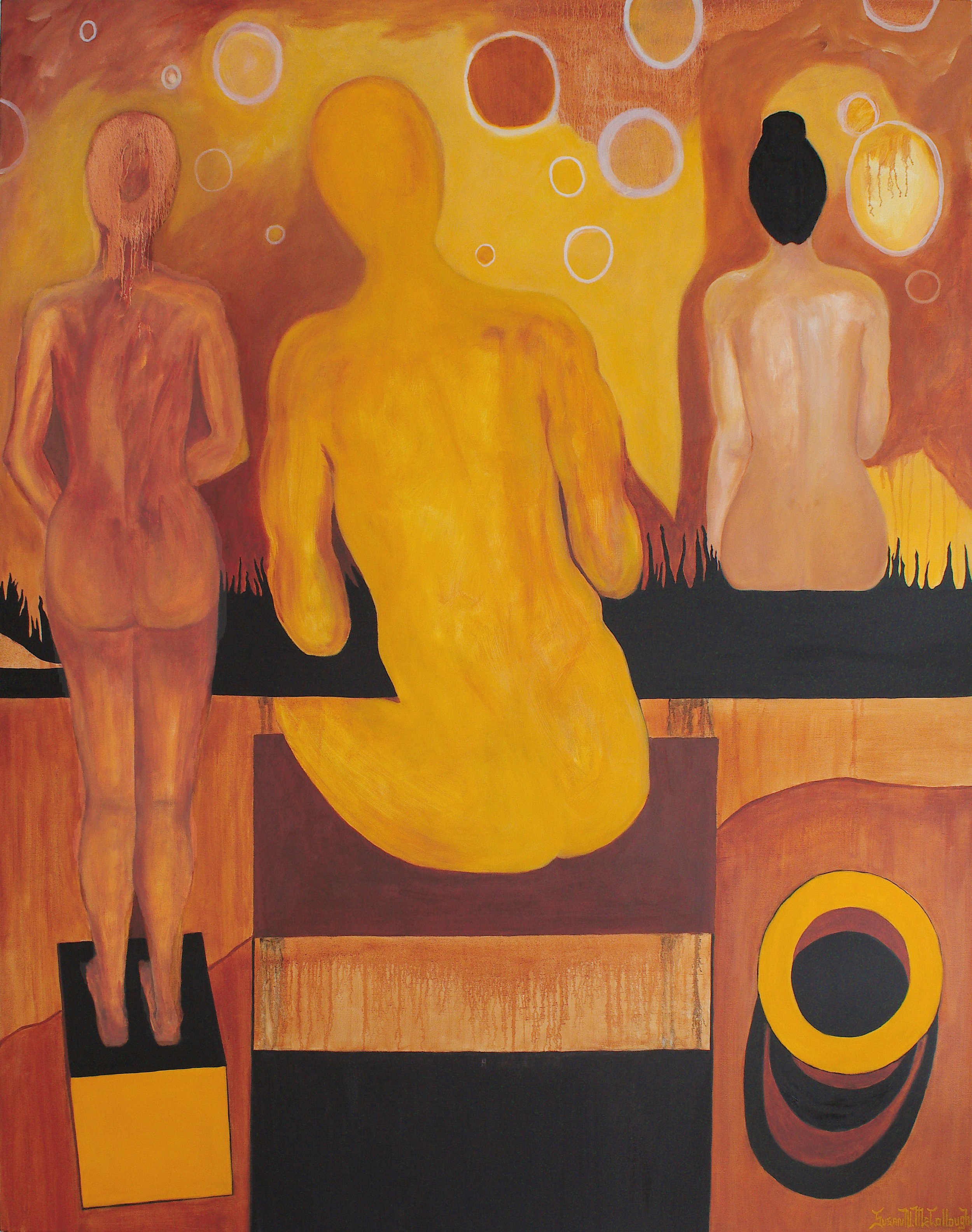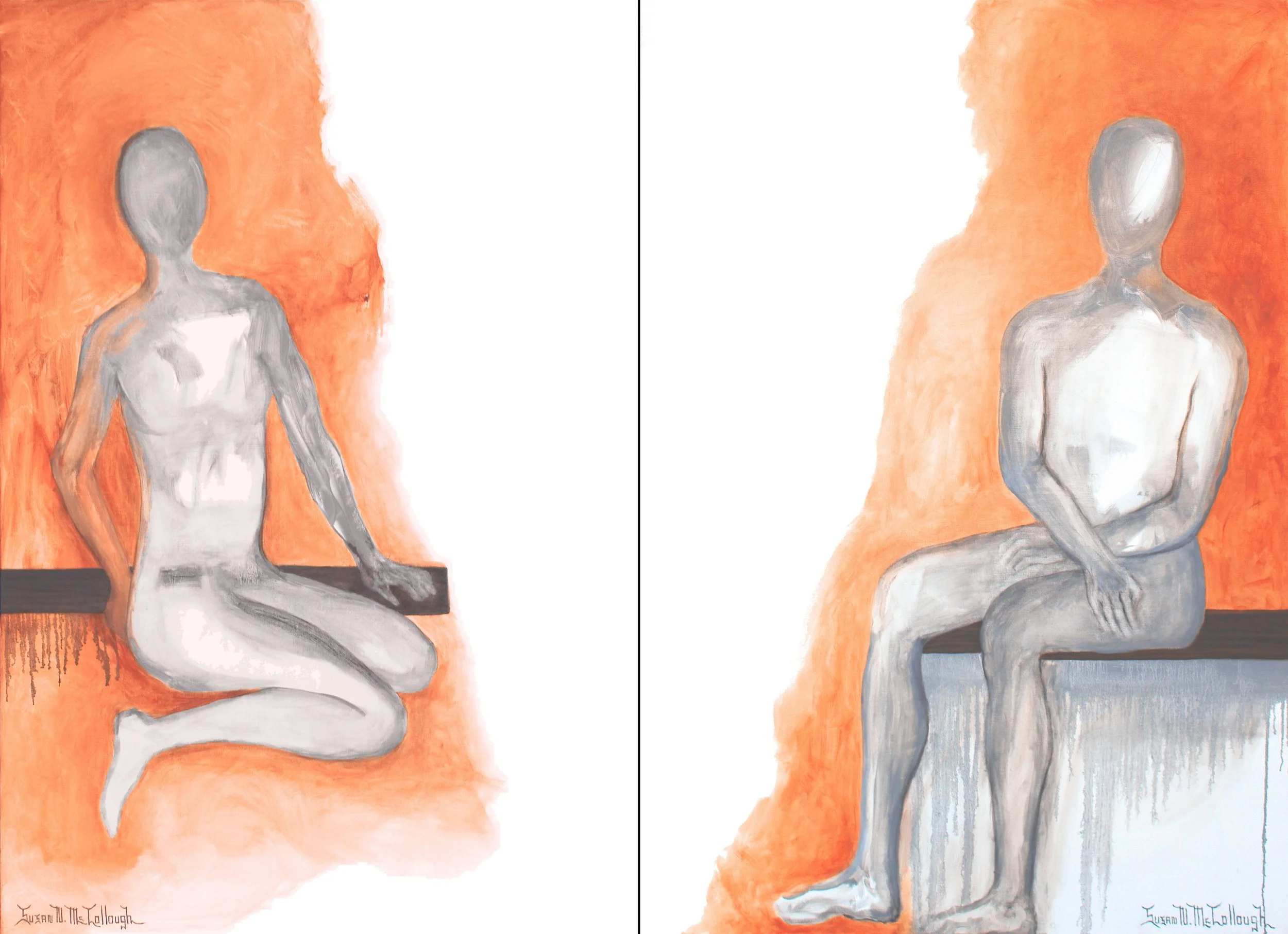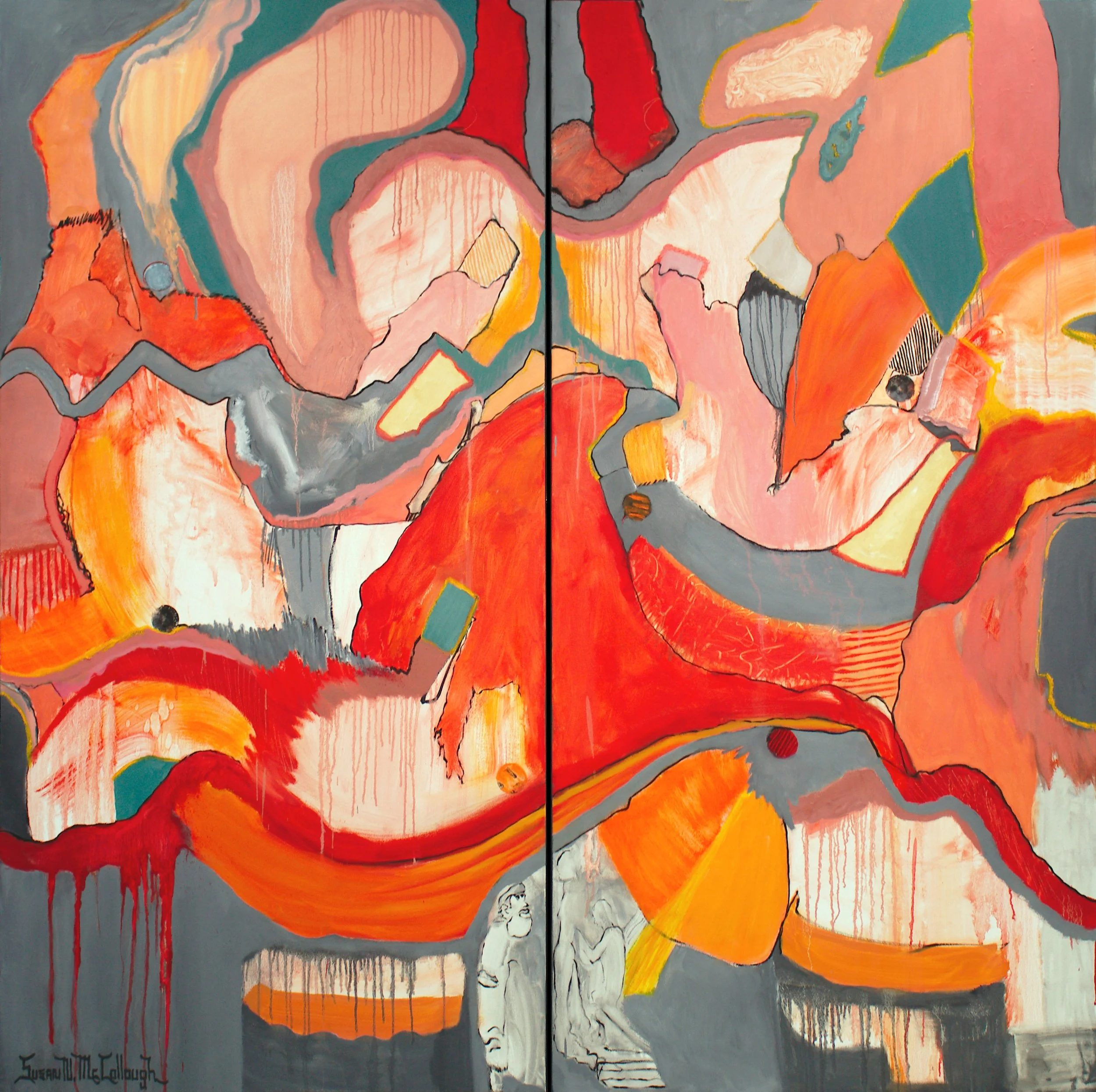Susan N. McCollough
https://www.susannmccolloughart.media/
To speak of Susan N. McCollough is to speak of an artist who inhabits the canvas with unrestrained vitality, drawing from a lifetime of experiences, intellectual pursuits, and intuitive resonance with the act of creation itself. Her paintings do not merely belong to the tradition of Abstract Expressionism; they renew and expand it, infusing it with personal mythology, architectural rhythm, and a chromatic fire that renders the surface a living event. McCollough’s oeuvre is one of freedom, not freedom as abandon, but freedom as clarity, as conviction, as alignment with the essential excitement of the blank canvas.
At the core of her artistic philosophy lies an idea both simple and profound: painting begins with the thrill of possibility. She has said, “I paint from the excitement of the blank canvas… with freedom of inner feelings, movement, connection of space, combination of colors, playing with negative space until it all speaks to me.” This is not the rhetoric of a painter searching for external referents but of one who understands painting as a primary language, a direct articulation of being. McCollough does not paint what she sees; she paints what arises when vision, memory, travel, architecture, and the quiet pulse of emotion converge into gesture.
Her life and career bear witness to this ethos of vitality. Born in the Bronx and raised in Alabama, McCollough’s trajectory moves through multiple identities: beauty queen, actress, sculptor, painter, patron, benefactor, yet always circles back to art as the axis. She studied at the University of Alabama under Alvin C. Sella, and her education continued through encounters with figures such as Sonia De Franceschi in Florence and Michael Mentler in Dallas. She worked in sculpture, gold leafing, and the Old Masters’ techniques, grounding her in traditions she later broke open with the explosive energy of her canvases. Her gallery and institute in Gulf Shores, Alabama, stood for more than a decade as both sanctuary and platform, before she chose to move her studio into her home, its glass walls opening to the presence of her horses, a luminous reminder that art, for her, is always in dialogue with life itself.
McCollough’s career is not only personal but institutional. She is a co-benefactor of the McCollough Initiative at the University of Alabama, a biennial platform for artists that fosters dialogue across generations. Her work as a sculptor includes busts of Coach Nick Saban in multiple museum collections, and her service on the United States Sports Academy’s Board of Trustees demonstrates her commitment to the intersection of art, athletics, and public culture. Honors such as Art Tour International’s “Artist of the Year” and her feature in the Art Titans documentary series situate her not only as an individual creator but as a force shaping the larger cultural scene.
But it is on the canvas itself that her vision becomes most resonant.
Consider “Illusionary Journey” (2016), a monumental oil on canvas. Here, color fields collide—crimson, yellow, black, green—yet the structure is not chaos. Instead, it is orchestration. The painting embodies a journey not as a linear narrative but as simultaneity: fragmented forms press against geometric partitions, circular orbs vibrate with symbolic resonance, and the diagonal vectors of black carve paths through the fiery chromatic mass. This is an abstraction as a narrative, where the story unfolds not in figures but in the collision of energies.
By contrast, “Her Earthly Vision” (2016) offers an intimacy within its abstraction. The forms suggest feminine corporeality, yet dissolve into fluid sweeps of paint that speak to embodiment beyond figure. Vision here is not ocular but internal: a seeing with the body, with memory, with intuition. The painting’s earthy tones—ochres, reds, muted greens—anchor the viewer in soil and flesh, even as the gestural lines lift upward into transcendence.
In “Between the Lines” (2015), McCollough dramatizes the interplay of order and spontaneity. Black-and-white stripes meet raw gestures of red and yellow; figurative traces emerge only to be obscured. It is a meditation on the very grammar of abstraction—the “lines” are not simply compositional but metaphorical, suggesting both the limits within which we live and the spaces of freedom we claim between them.
The sheer scale and intensity of her work become palpable in the diptychs. “Counterpart I & II” (2019) speaks in dialogue across canvases. The reds and grays swirl into forms that evoke bodies in motion, yet never settle into representational clarity. They are counterparts not in symmetry but in resonance—two canvases that speak as one, embodying the relational nature of identity and perception. Similarly, her newest diptych, “Figuratively Speaking I & II” (2025), situates abstraction at the threshold of figuration. Here, shadowy human forms appear, spectral presences rendered in restrained gray and white against the fiery orange ground. The diptych becomes a meditation on presence and absence, on the way bodies exist in space as both material and immaterial.
Perhaps the most striking feature of McCollough’s art is her manipulation of space. Negative space is never empty in her hands. Instead, it vibrates as an active participant, a counterpoint to her explosions of color. In “Abstract 2020”, this dynamic is at its height: broad sweeps of red, yellow, and black stretch across the canvas, but it is the white intervals, the spaces of restraint, that allow the colors to breathe and expand. The painting becomes a lesson in rhythm—color as sound, space as silence.
“Interdimensional Perspective” (2024) pushes this further, suggesting not simply spatial depth but metaphysical multiplicity. Layers of paint overlap like veils, creating a sense of portals, of thresholds between dimensions. The work is not only about painting as surface but painting as passage, as if each brushstroke opens onto another world.
In “Untitled 508” (2024), McCollough demonstrates her mastery of restraint. The composition is simpler, yet no less powerful: gestural lines cut across a restrained palette, evoking an architecture of movement. The title’s anonymity, “Untitled,” underscores the universal quality of the work: it is not about naming but about feeling, about inhabiting abstraction as an emotional state.
Her command of black and white is no less striking. “Monochromatic Abstraction” (date unspecified, black-and-white composition) reveals her ability to strip painting of color without losing intensity. The drips and gestures become more visible, rawer, as if the skeleton of her process is laid bare. In the absence of hue, structure itself becomes radiant.
While McCollough is often spoken of as an abstract painter, figuration haunts her canvases like memory. “The Guardian” (2015) is exemplary: a blazing orange figure, luminous against black and white stripes, emerges with both vulnerability and authority. The head, rendered as a glowing orb, suggests a being at once human and cosmic. Guardian here is not a protector in a literal sense but an archetype, a manifestation of presence itself.
“Figuratively Speaking I & II” (2025), as mentioned earlier, extends this exploration of figuration, balancing abstraction and bodily presence. Similarly, “The Diptych with Seated Figures” (2018, untitled in your archive)shows spectral human forms in gray against fields of orange, embodying the tension between materiality and dissolution. McCollough treats the human figure not as a likeness but as an essence, as a silhouette of being.
In “Into the Wild” (2021), figuration becomes almost mythological. The forms dissolve into landscapes of color, yet the suggestion of bodies, of creatures, lingers. The wild here is not merely external nature but internal wilderness, the untamed spaces of psyche and passion.
Susan N. McCollough’s importance lies not only in the brilliance of her canvases but in her position within contemporary culture. She works within the lineage of Abstract Expressionism, its insistence on gesture, scale, and freedom, but renews it by anchoring abstraction in lived experience. Her paintings are not exercises in style but articulations of being: they emerge from travel, from memory, from horses grazing outside her studio window, from dreams envisioned before sleep.
In this sense, she recalls the ethos of Willem de Kooning, the one historical figure with whom comparison feels most apt. Like de Kooning, McCollough refuses the false dichotomy between abstraction and figuration; she allows bodies to emerge and dissolve within the same surface. Like de Kooning, she embraces color as a material force, gesture as revelation. Yet her work departs from his in its philosophical tenor. Where de Kooning’s women were often fraught, fractured, McCollough’s presences—whether abstract or figurative—radiate affirmation. They are not torn but luminous, embodiments of transformation rather than struggle.
Her contributions extend beyond the canvas to her institutional legacy. Through the McCollough Initiative, she ensures that younger generations of artists have platforms she herself had to fight to find. Through her gallery and now her ranch studio, she embodies the model of an artist who not only creates but curates, not only paints but builds structures of cultural support.
Susan N. McCollough’s art matters because it insists on freedom. Freedom not as chaos, but as disciplined openness to the unknown. Each canvas begins as a site of possibility, and through her labor of love, her brushstrokes, her colors, her embrace of space, it becomes a site of revelation. She reminds us that art is not about depicting what already exists, but about bringing into being what has not yet been seen.
Her paintings, whether fiery with reds and yellows or restrained in monochrome, carry the same force: they are encounters with the energy of life itself. They speak to the viewer not through representation but through resonance, activating the inner sense of beauty, freedom, and transformation.
In the end, McCollough’s greatest gift is this: she offers the blank canvas as a mirror of existence, and she shows us that to face it with courage and joy is to discover not only art, but ourselves.
To reflect on Susan N. McCollough’s art is to encounter a body of work that reaffirms the courage of invention. Her canvases remind us that the blank surface is not an emptiness to be feared, but a threshold to be crossed. In every brushstroke, she rehearses the possibility of transformation: from stillness to movement, from silence to sound, from absence to presence.
In this sense, McCollough’s practice becomes emblematic of the artist’s role in society today. At a moment when distraction threatens to dilute vision and when conformity pressures the individual into silence, her paintings stand as evidence of another way of being. They are fiercely independent, uncompromisingly personal, yet they carry with them an invitation to the collective. Every viewer who enters their orbit is asked not only to look but to feel, to risk alignment with their own inner movement, their own blank canvas waiting to be filled.
Her philosophy, that she paints from the sheer excitement of beginning, has profound implications. It suggests that creation is less about the finished object than about a state of openness, a readiness to encounter the unknown. This is why her works, regardless of scale or medium, carry an energy that feels inexhaustible. They do not merely decorate space; they transform it. They are environments of color and gesture in which viewers find themselves reflected, not as static beings but as living processes.
McCollough’s art also speaks to continuity. From her studies of the Old Masters to her embrace of Abstract Expressionism, from her sculptures of iconic figures to her vast canvases of pure abstraction, she has built a practice that bridges epochs, genres, and traditions. Yet at no point does her work lapse into pastiche. Each canvas declares itself as singular, the result of a life lived in dialogue with history but unafraid to move beyond it.
Ultimately, McCollough’s paintings remind us that art is not about resolving contradictions but inhabiting them. They dwell in the tension between abstraction and figuration, freedom and discipline, presence and absence. And in that tension, they find beauty.
Her legacy, already visible in the institutions she has built and the works she has shared, is one of luminous generosity. She paints, as she lives, with the conviction that beauty is not a luxury but a necessity, a language through which we discover, again and again, what it means to be human.
By Marta Puig
Editor Contemporary Art Curator Magazine
INTO THE WILD, 2021, Oil on Canvas, 162 x 193 cm
ILLUSIONARY JOURNEY, 2016, Oil on Canvas, 122 x 213 cm
ABSTRACT 2020, 2020, Oil on Canvas, 122 x 183 cm
BETWEEN THE LINES, 2015, Oil on Linen, 114 x 160 cm
THE GUARDIAN, 2015, Oil on Canvas, 114 x 160 cm
INTERDIMENSIONAL PERSPECTIVE, 2024, Oil on Canvas, 183 x 152 cm
UNTITLED 508, 2024, Oil on Canvas, 122 x 183 cm
FIGURATIVELY SPEAKING I & II, 2025, Diptych Oil on Canvas, 228 x 160 cm
HER EARTHLY VISION, 2016, Oil on Canvas, 152 x 122 cm
COUNTERPART I & II, 2019, Diptych Oil on Canvas, 183 x 183 cm
